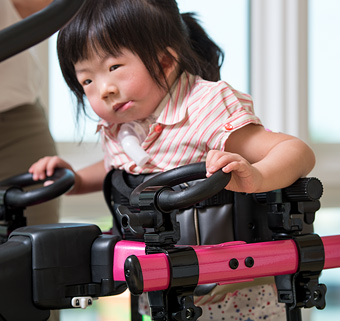Evidence Update
Comparing Inertial Properties of Three Pediatric Gait Trainers
| February 2016 Children with disabilities benefit both physically and socially from opportunities for independent mobility. This has been well-established (and documented) in the therapy community. In cases where children can’t ambulate independently, supportive gait training equipment helps them move to their maximum potentials.
Children with disabilities benefit both physically and socially from opportunities for independent mobility. This has been well-established (and documented) in the therapy community. In cases where children can’t ambulate independently, supportive gait training equipment helps them move to their maximum potentials.
Currently there are a number of adaptive gait trainers available to this population. But there are no studies comparing their effectiveness to help the clinician choose the right gait trainer for her student. For this reason, Paleg and colleagues initiated a study mainly to measure inertial properties and the forces needed to initiate movement of three commonly used pediatric gait trainers: the KidWalk by Prime Engineering, the Pacer by Rifton and the Mustang by R82.
For the study, the team used weighted dummies configured to the proportions of a four-year-old child and placed them in each gait trainer. They then ran tests to get the gait trainer moving, both on tile and on carpeted floors. Although all three gait trainers cover a similar footprint size, wheel sizes and gait trainer load distributions were distinctly different.
Overall, the forces needed to start each gait trainer were fairly low. However, on tiled surfaces, the Pacer and KidWalk moved most easily (the Mustang required 20% more force to accelerate) whereas on carpet, the KidWalk accelerated the easiest (Mustang and Pacer required 25% more force to accelerate). Of the three, the Pacer is the lightest in weight, followed by the Mustang and then the KidWalk.
As far as we know this is the first such study. Anyone facing a gait trainer selection decision will find it helpful and instructive.
Note: Since this study was conducted Rifton has introduced a newly designed gait trainer. However, the new design is almost 15% lighter than the old-style Pacer, so the study’s findings are still relevant and timely.
Source: Paleg G, Huang M, Gabela S, Sprigle S, Livingstone R., “Comparison of the Inertial Properties and Forces Required to Initiate Movement for Three Gait Trainers.” Assistive Technology, 2016, DOI: 10.1080/10400435.2015.1123780




